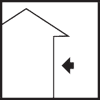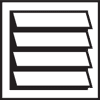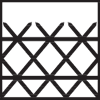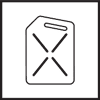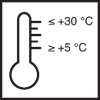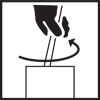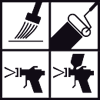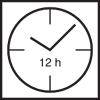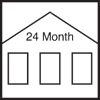Article No. 715003
Adhesive primer for metals, rigid plastics and wood, protects against rust and seals off substances in the wood
Product specifications
The stated values represent typical product characteristics and are not to be construed as binding product specifications.
Field of application
- For use on exterior wood
- Wood containing high levels of substances that can cause staining and exotic wood (e.g. Bangkirai, Moabi, Massaranduba, Kasai, Kambala, Framire, Hevea, Sapele, Sipo, Meranti, oak, ash)
- Primer and intermediate coat
- Dimensionally stable wood building elements: e.g. windows and doors
- Wood building elements with limited dimensional stability, e.g. folding shutters, matchboarding, summerhouses
- Wood building elements with no dimensional stability: e.g. fences, framework, carports, planking
- Rigid PVC
- Metal substrates, e.g. (galvanised) steel, pure aluminium, copper, brass
Properties
- Very good adhesion to the substrate
- Reduces yellow stains caused by water soluble substances in the wood when light shades of finishing coat are used
- Film preserver protects against microbial damage
- Good edge coverage
- Very good covering power
- High degree of pore filling
- Protects against corrosion
- Can be overcoated with many products: (see system products)
-
Preparation
-
Substrate requirements
The substrate must be clean, dust-free and dry.
Dimensionally stable wood building elements: wood moisture content 11-15%
Wood building elements with limited or no dimensional stability: wood moisture content max. 18%
-
Preparations
Thoroughly remove any dirt, grease and non-adhering old coatings.
Exterior wood:
Sand grey and weathered wood surfaces down to sound, bright wood.
Remove any loose and torn knots as well as resin that bleeds from the wood and clean with a suitable product (e.g. V 101 Thinner).
Use IG-10 Impregnation Primer IT* to pre-treat exterior wood requiring protection against insects, soft rot and blue stain. (*Use biocides safely. Always read the label and product information before use.)
Observe BFS Code of Practice No. 18 "Coatings on Wood and Wooden Working Materials in Outdoor Areas".
Iron, steel:
Derust thoroughly. Remove scale layers and rolling skin (derust manually to SA 3 standard of cleanliness). The best results are achieved if the substrate has been sand blasted to SA 2.5 standard of cleanliness (DIN EN ISO 12944-4).
Sanded metal finish: P 150 - P 180.
Round off sharp edges and ridges.
Refer to BFS Code of Practice No. 20.
Zinc (galvanised steel):
Clean with an ammonium-based wetting agent, using an abrasive pad. Observe BFS Code of Practice No. 5.
Aluminium:
Clean with V 101 or V-890 thinner, or a cleaning agent that contains phosphoric acid. Observe BFS Code of Practice No. 6.
Plastics:
Treat rigid PVC, PUR, polyester, acrylic, and melamine resin coatings (Resopal) with V 101 or V-890 thinner and an abrasive pad.
-
-
Application
-
Stir well.
Apply with a brush, roller or by spraying.
Airmix spraying: nozzle size: 0.23 - 0.28 mm, material pressure: 80 - 100 bar, atomiser air pressure: 1.2 - 2 bar.
Airless spraying: nozzle size: 0.23 - 0.28 mm, material pressure: 70 - 80 bar.
Flow cup gun: nozzle size: 2.0 - 2.5 mm; atomiser air pressure: 2.0 - 3.0 bar.
After drying and intermediate sanding, coat with a water-based or solvent-based lacquer.
Observe the waiting times between coats.
-
Application instructions
-
Check the product’s compatibility, adhesion and sealing effect on the substrate by applying to trial areas.
Areas that are being coated or dried should be protected against rain, wind, sunlight and condensation.
-
Drying
Dust-dry: after approx. 1 hour
Ready for next coat: after approx. 12 hoursPractice values at +20 °C and 65% relative humidity.
If a water-based finish is used, overnight drying is required.
Low temperatures, poor ventilation and high humidity delay drying.
-
Thinning
If necessary, dilute with max. 10% Thinner V 101.
-
Working tools / cleaning
-
Brush with natural bristles, flat brush, foam roller, airmix/airless spraying equipment, flow cup gun
-
Clean tools immediately after use with V 101 Thinner.
Ensure that any residue from cleaning is disposed of correctly.
-
Storage / shelf life
-
If stored unopened in its original container in a cool, dry place and protected against frost, the product will keep for at least 24 months.
-
Usage
-
As an adhesive primer and to seal off substances in the wood: 80 - 100 ml/m² depending on the substrate
For corrosion protection: 2 x 100 ml/m²
-
General information
-
Insulation of resins and substances contained in the wood.
If discolouration continues even after following these steps, we recommend contacting our RTS (Remmers Technical Service).
Bleeding resin is a natural phenomenon and cannot be prevented by coating measures, see BFS Code of Practice No. 18.
The mineral content naturally found in exotic woods may cause discolouration.
On planed larch and softwoods with a high resin content, the coating may have reduced adhesion and resistance to weathering. This is especially the case on horizontal year rings, knots and areas of winter growth that are high in resin. Maintenance and renovation must be carried out more frequently on these surfaces.
The only remedy for this is pre-weathering or very coarse sanding (P80).
If these wood types are rough-sawn, considerably longer maintenance and renovation intervals are to be expected.
-
-
Disposal instructions
-
Larger quantities of leftover product should be disposed of in the original containers in accordance with the applicable regulations. Completely empty, clean containers should be recycled. Do not dispose of together with household waste. Do not allow to enter the sewage system. Do not empty into drains.
-
-
Safety / regulations
-
For further information on the safety aspects of transporting, storing and handling the product and on disposal and environmental matters, please see the current Safety Data Sheet.
-


